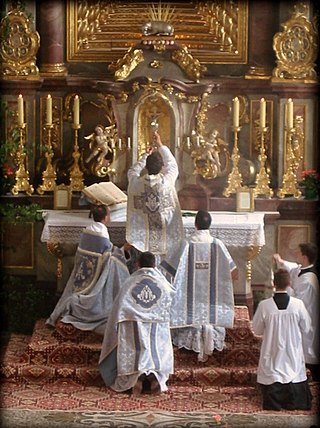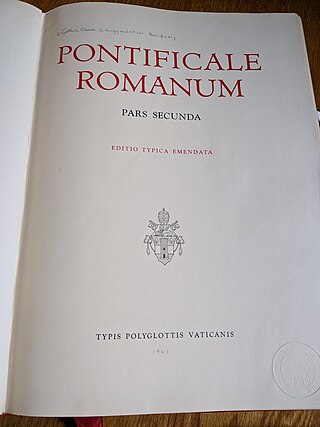This article relies largely or entirely on a single source .(January 2024) |

The Cistercian Rite is the liturgical rite, distinct from the Roman Rite, specific to the Cistercian Order of the Catholic Church.
This article relies largely or entirely on a single source .(January 2024) |

The Cistercian Rite is the liturgical rite, distinct from the Roman Rite, specific to the Cistercian Order of the Catholic Church.
The Cistercian Rite is to be found in the liturgical books of this reformed branch of the Benedictines. The collection, composed of fifteen books, was made by the General Chapter of Cîteaux (the place from which the order takes its name), most probably in 1134; they were later included in the Missal, Breviary, Ritual and Martyrology of the order. When Pope Pius V ordered the entire Church to conform to the Roman Missal and Roman Breviary, he exempted the Cistercians, because their rite had been more than 200 years in existence. Under Claude Vaussin, General of the Cistercians in the middle of the seventeenth century, several reforms were made in the liturgical books of the order, and were approved by Pope Alexander VII, Pope Clement IX and Pope Clement XIII. These approbations were confirmed by Pope Pius IX on 7 February 1871 for the Cistercians of the Common and the Strict Observance (Trappists). [1]
The Cistercian canonical hours (or Divine Office) was even then quite different from the Roman, as it followed exactly the prescriptions of the Rule of St. Benedict (see Benedictine Rite), with a very few minor additions. [1]
In the Cistercian Missal before the reform of Claude Vaussin, there were wide divergences between the Cistercian and Roman rites. The psalm "Judica" was not said, but in its stead was recited the Veni Creator; the Indulgentiam was followed by the Pater and Ave, and the Oramus te Domine was omitted in kissing the altar. After the Pax Domini sit semper vobiscum, the Agnus Dei was said thrice, and was followed immediately by Hæc sacrosancta commixtio corporis, said by the priest while placing the small fragment of the Sacred Host in the chalice; then the Domine Jesu Christe, Fili Dei Vivi was said, but the Corpus Tuum and Quod ore sumpsimus were omitted. The priest said the Placeat, and then "Meritis et precibus istorum et omnium sanctorum. Suorum misereatur nostri Omnipotens Dominus. Amen", while kissing the altar; he also ended Mass with the sign of the Cross. Outside of some minor exceptions in the wording and conclusions of various prayers, the other parts of the Mass were the same as in the Roman Rite. Also in some Masses of the year the ordo was different; for instance, on Palm Sunday the Passion was only said at the high Mass, at the other Masses a special gospel only being said. However, since the time of Claude Vaussin the differences from the Roman Mass became insignificant. [1]
The differences in the ritual were very small. As regards the last sacraments, Extreme Unction was given before the Holy Viaticum, and in Extreme Unction the word Peccasti was used instead of the Deliquisti that was then in the Roman Ritual. In the Sacrament of Penance a shorter form of absolution might be used in ordinary confessions. [1]

The Tridentine Mass, also known as the Traditional Latin Mass, the Traditional Rite, or the Extraordinary Form, is the liturgy in the Roman Missal of the Catholic Church codified in 1570 and published thereafter with amendments up to 1962. Celebrated almost exclusively in Ecclesiastical Latin, it was the most widely used Eucharistic liturgy in the world from its issuance in 1570 until the introduction of the Mass of Paul VI.

The Ambrosian Rite is a Latin liturgical rite of the Catholic Church. The rite is named after Saint Ambrose, a bishop of Milan in the fourth century. It is used by around five million Catholics in the greater part of the Archdiocese of Milan, in some parishes of the Diocese of Como, Bergamo, Novara, Lodi, and in the Diocese of Lugano, Canton of Ticino, Switzerland.

The Roman Ritual is one of the official liturgical books of the Roman Rite of the Latin Church of the Catholic Church. It contains all of the services that a priest or deacon may perform; and are not contained in the Missale Romanum, Pontificale Romanum, or Caeremoniale Episcoporum, but for convenience does include some rituals that one of these books contains.
Quattuor abhinc annos is the incipit of a letter that the Congregation for Divine Worship and the Discipline of the Sacraments sent on 3 October 1984 to presidents of episcopal conferences concerning celebration of Mass in the Tridentine form.
The ordinary, in Catholic liturgies, refers to the part of the Mass or of the canonical hours that is reasonably constant without regard to the date on which the service is performed. It is contrasted to the proper, which is that part of these liturgies that varies according to the date, either representing an observance within the liturgical year, or of a particular saint or significant event, or to the common which contains those parts that are common to an entire category of saints such as apostles or martyrs.

The Roman Rite is the most common ritual family for performing the ecclesiastical services of the Latin Church, the largest of the sui iuris particular churches that comprise the Catholic Church. The Roman Rite governs rites such as the Roman Mass and the Liturgy of the Hours as well as the manner in which sacraments and blessings are performed.

The term "Celtic Rite" is applied to the various liturgical rites used in Celtic Christianity in Britain, Ireland and Brittany and the monasteries founded by St. Columbanus and Saint Catald in France, Germany, Switzerland, and Italy during the Early Middle Ages. The term is not meant to imply homogeneity; instead it is used to describe a diverse range of liturgical practices united by lineage and geography.

Pre-Tridentine Mass refers to the evolving and regional forms of the Catholic Mass in the West from antiquity to 1570.

Latin liturgical rites, or Western liturgical rites, is a large family of liturgical rites and uses of public worship employed by the Latin Church, the largest particular church sui iuris of the Catholic Church, that originated in Europe where the Latin language once dominated. Its language is now known as Ecclesiastical Latin. The most used rite is the Roman Rite.
A Catholic order liturgical rite is a variant of a Catholic liturgical rite distinct from the typical ones, such as the Roman Rite, but instead specific to a certain Catholic religious order.

The Rite of the Holy Sepulchre, commonly called the Carmelite Rite, is the liturgical rite that was used by the Canons Regular of the Holy Sepulchre, Hospitallers, Templars, Carmelites and the other orders founded within the Latin Patriarchate of Jerusalem.

The Premonstratensian Rite or Norbertine Rite is the liturgical rite, distinct from the Roman Rite, specific to the Premonstratensian Order of the Roman Catholic Church

The Dominican Rite is the unique liturgical rite of the Dominican Order in the Catholic Church. It has been classified differently by different sources – some consider it a usage of the Roman Rite, others a variant of the Gallican Rite, and still others a form of the Roman Rite into which Gallican elements were inserted.

The Mass is the central liturgical service of the Eucharist in the Catholic Church, in which bread and wine are consecrated and become the body and blood of Christ. As defined by the Church at the Council of Trent, in the Mass "the same Christ who offered himself once in a bloody manner on the altar of the cross, is present and offered in an unbloody manner". The Church describes the Mass as the "source and summit of the Christian life", and teaches that the Mass is a sacrifice, in which the sacramental bread and wine, through consecration by an ordained priest, become the sacrificial body, blood, soul, and divinity of Christ as the sacrifice on Calvary made truly present once again on the altar. The Catholic Church permits only baptised members in the state of grace to receive Christ in the Eucharist.
Summorum Pontificum is an apostolic letter of Pope Benedict XVI, issued in July 2007. This letter specifies the circumstances in which priests of the Latin Church could celebrate Mass according to what Benedict XVI called the "Missal promulgated by Blessed John XXIII in 1962" and administer most of the sacraments in the form used before the liturgical reforms that followed the Second Vatican Council.

The Roman Pontifical is the pontifical as used in Roman Rite liturgies of the Catholic Church. It is the liturgical book that contains the rites and ceremonies usually performed by bishops.
The liturgical reforms of Pope Pius XII took place mostly between 1947 and 1958.

The liturgical books of the Roman Rite are the official books containing the words to be recited and the actions to be performed in the celebration of Catholic liturgy as done in Rome. The Roman Rite of the Latin or Western Church of the Catholic Church is the most widely celebrated of the scores of Catholic liturgical rites. The titles of some of these books contain the adjective "Roman", e.g. the "Roman Missal", to distinguish them from the liturgical books for the other rites of the Church.
Rubricarum instructum is an apostolic letter of Pope John XXIII issued motu proprio on July 25, 1960 promulgating the new Code of Rubrics for both the Roman Breviary and the Roman Missal.

In the Catholic Church, preconciliar Latin liturgical rites coexist with postconciliar rites. In the years following the Second Vatican Council, Pope Paul VI initiated significant changes. Some of Paul VI's contemporaries, who considered the changes to be too drastic, obtained from him limited permission for the continued use of the previous Roman Missal. In the years since, the Holy See has granted varying degrees of permission to celebrate the Roman Rite and other Latin rites in the same manner as before the council. The use of preconciliar rites is associated with traditionalist Catholicism.